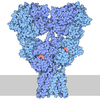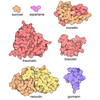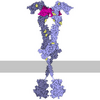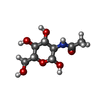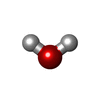Entry Database : PDB / ID : 3jpwTitle Crystal structure of amino terminal domain of the NMDA receptor subunit NR2B Glutamate [NMDA] receptor subunit epsilon-2 Keywords / / / / / / / / / / / / / / / / Function / homology Function Domain/homology Component
/ / / / / / / / / / / / / / / / / / / / / / / / / / / / / / / / / / / / / / / / / / / / / / / / / / / / / / / / / / / / / / / / / / / / / / / / / / / / / / / / / / / / / / / / / / / / / / / / / / / / / / / / / / / / / / / / / / / / / / / / / / / / / / / / / / / / / Biological species Rattus norvegicus (Norway rat)Method / / / Resolution : 2.803 Å Authors Karakas, E. / Simorowski, N. / Furukawa, H. Journal : Embo J. / Year : 2009Title : Structure of the zinc-bound amino-terminal domain of the NMDA receptor NR2B subunit.Authors : Karakas, E. / Simorowski, N. / Furukawa, H. History Deposition Sep 4, 2009 Deposition site / Processing site Revision 1.0 Dec 8, 2009 Provider / Type Revision 1.1 Jul 13, 2011 Group / Version format complianceRevision 1.2 Nov 1, 2017 Group / Category Revision 1.3 Jul 29, 2020 Group Advisory / Data collection ... Advisory / Data collection / Derived calculations / Structure summary Category chem_comp / database_PDB_caveat ... chem_comp / database_PDB_caveat / entity / pdbx_chem_comp_identifier / pdbx_entity_nonpoly / struct_conn / struct_site / struct_site_gen Item _chem_comp.name / _chem_comp.type ... _chem_comp.name / _chem_comp.type / _entity.pdbx_description / _pdbx_entity_nonpoly.name / _struct_conn.conn_type_id / _struct_conn.id / _struct_conn.pdbx_dist_value / _struct_conn.pdbx_leaving_atom_flag / _struct_conn.pdbx_role / _struct_conn.ptnr1_auth_comp_id / _struct_conn.ptnr1_auth_seq_id / _struct_conn.ptnr1_label_atom_id / _struct_conn.ptnr1_label_comp_id / _struct_conn.ptnr1_label_seq_id / _struct_conn.ptnr2_auth_comp_id / _struct_conn.ptnr2_auth_seq_id / _struct_conn.ptnr2_label_asym_id / _struct_conn.ptnr2_label_atom_id / _struct_conn.ptnr2_label_comp_id Description / Provider / Type Revision 1.4 Oct 13, 2021 Group / Structure summary / Category / database_2 / struct_ref_seq_difItem _chem_comp.pdbx_synonyms / _database_2.pdbx_DOI ... _chem_comp.pdbx_synonyms / _database_2.pdbx_DOI / _database_2.pdbx_database_accession / _struct_ref_seq_dif.details Revision 1.5 Oct 30, 2024 Group / Structure summaryCategory chem_comp_atom / chem_comp_bond ... chem_comp_atom / chem_comp_bond / pdbx_entry_details / pdbx_modification_feature
Show all Show less
 Yorodumi
Yorodumi Open data
Open data Basic information
Basic information Components
Components Keywords
Keywords Function and homology information
Function and homology information
 X-RAY DIFFRACTION /
X-RAY DIFFRACTION /  SYNCHROTRON /
SYNCHROTRON /  MIRAS / Resolution: 2.803 Å
MIRAS / Resolution: 2.803 Å  Authors
Authors Citation
Citation Journal: Embo J. / Year: 2009
Journal: Embo J. / Year: 2009 Structure visualization
Structure visualization Molmil
Molmil Jmol/JSmol
Jmol/JSmol Downloads & links
Downloads & links Download
Download 3jpw.cif.gz
3jpw.cif.gz PDBx/mmCIF format
PDBx/mmCIF format pdb3jpw.ent.gz
pdb3jpw.ent.gz PDB format
PDB format 3jpw.json.gz
3jpw.json.gz PDBx/mmJSON format
PDBx/mmJSON format Other downloads
Other downloads 3jpw_validation.pdf.gz
3jpw_validation.pdf.gz wwPDB validaton report
wwPDB validaton report 3jpw_full_validation.pdf.gz
3jpw_full_validation.pdf.gz 3jpw_validation.xml.gz
3jpw_validation.xml.gz 3jpw_validation.cif.gz
3jpw_validation.cif.gz https://data.pdbj.org/pub/pdb/validation_reports/jp/3jpw
https://data.pdbj.org/pub/pdb/validation_reports/jp/3jpw ftp://data.pdbj.org/pub/pdb/validation_reports/jp/3jpw
ftp://data.pdbj.org/pub/pdb/validation_reports/jp/3jpw Links
Links Assembly
Assembly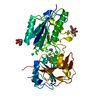
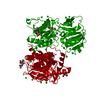
 Components
Components
 Trichoplusia ni (cabbage looper) / References: UniProt: Q00960
Trichoplusia ni (cabbage looper) / References: UniProt: Q00960 X-RAY DIFFRACTION / Number of used crystals: 1
X-RAY DIFFRACTION / Number of used crystals: 1  Sample preparation
Sample preparation SYNCHROTRON / Site:
SYNCHROTRON / Site:  NSLS
NSLS  / Beamline: X25 / Wavelength: 1 Å
/ Beamline: X25 / Wavelength: 1 Å MIRAS
MIRAS Processing
Processing MIRAS / Resolution: 2.803→28.931 Å / Occupancy max: 1 / Occupancy min: 0 / SU ML: 0.78 / σ(F): 1.34 / Phase error: 27.71 / Stereochemistry target values: ML
MIRAS / Resolution: 2.803→28.931 Å / Occupancy max: 1 / Occupancy min: 0 / SU ML: 0.78 / σ(F): 1.34 / Phase error: 27.71 / Stereochemistry target values: ML Movie
Movie Controller
Controller



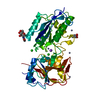


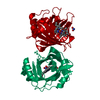
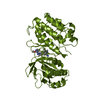
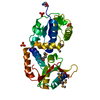
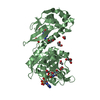
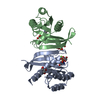
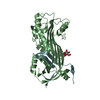
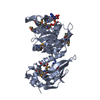
 PDBj
PDBj